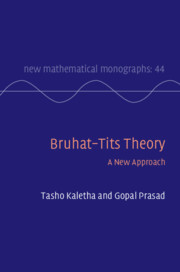Book contents
- Frontmatter
- Dedication
- Contents
- Illustrations
- Tables
- Introduction
- Part One Background and Review
- Part Two Bruhat–Tits Theory
- 3 Examples: Quasi-split Simple Groups of Rank 1
- 4 Overview and Summary of Bruhat–Tits Theory
- 5 Bruhat, Cartan, and Iwasawa Decompositions
- 6 The Apartment
- 7 The Bruhat–Tits Building for a Valuation of the Root Datum
- 8 Integral Models
- 9 Unramified Descent
- Part Three Additional Developments
- Part Four Applications
- Part Five Appendices
- References
- Index of Symbols
- General Index
6 - The Apartment
from Part Two - Bruhat–Tits Theory
Published online by Cambridge University Press: 16 May 2023
- Frontmatter
- Dedication
- Contents
- Illustrations
- Tables
- Introduction
- Part One Background and Review
- Part Two Bruhat–Tits Theory
- 3 Examples: Quasi-split Simple Groups of Rank 1
- 4 Overview and Summary of Bruhat–Tits Theory
- 5 Bruhat, Cartan, and Iwasawa Decompositions
- 6 The Apartment
- 7 The Bruhat–Tits Building for a Valuation of the Root Datum
- 8 Integral Models
- 9 Unramified Descent
- Part Three Additional Developments
- Part Four Applications
- Part Five Appendices
- References
- Index of Symbols
- General Index
Summary
The development of Bruhat--Tits theory begins with this chapter. The main purpose of this chapter is to define the apartment associated to a maximal $k$-split torus. The fundamental object used in the construction of the apartment is the notion of a \emph{valuation of the root datum} due to Bruhat--Tits and the equivalence relation on such valuations called \emph{equipollence}. An apartment is by definition an equipollence class of valuations of root data. When the group $G$ is quasi-split we show that there is a canonical such equipollence class for each maximal $k$-split torus of $G$. It is constructed using a Chevalley basis, or, more generally, a Chevalley--Steinberg system. When $G$ is not quasi-split we take the existence of an equipollence class as an abstract input, to be specified later. In addition to the apartment, we discuss in this chapter the affine root system and the affine Weyl group, as well as compatibility with Levi subgroups.
Information
- Type
- Chapter
- Information
- Bruhat–Tits TheoryA New Approach, pp. 195 - 234Publisher: Cambridge University PressPrint publication year: 2023
